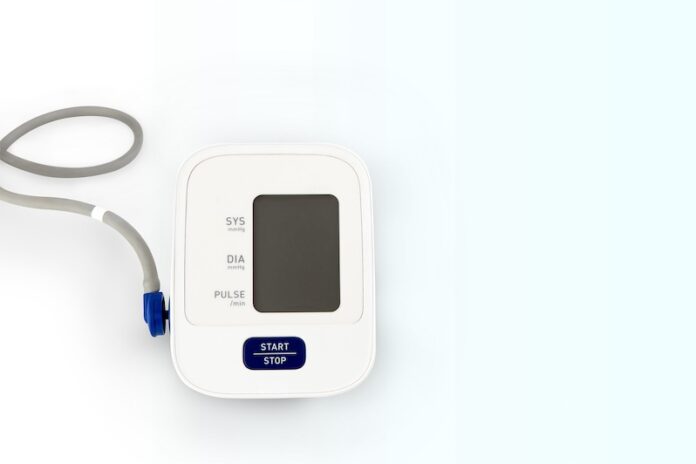lood pressure is the amount of pressure applied by circulating blood to blood vessels. The measurement and assessment of blood pressure is based on the values for the systolic blood pressure (top number) and the diastolic blood pressure (bottom number). Systolic blood pressure is the maximum pressure exerted on blood vessels during a contraction of the heart, while diastolic blood pressure is the minimum pressure exerted in between heart contractions. The ideal blood pressure varies depending on factors like the risk of heart disease and other medical conditions (e.g., diabetes), but the target blood pressure for most people is a systolic pressure of ≤ 140 mm Hg and a diastolic pressure of ≤ 90 mm Hg (i.e. below 140/90 mm Hg).
What is orthostatic hypotension?
Orthostatic hypotension (OH) is defined as the decrease in systolic blood pressure by ≥ 20 mm Hg or diastolic BP of ≥ 10 mm Hg after moving from a sitting or kneeling position to a standing position. OH occurs due to an inability to compensate and stabilize the reduction in blood pressure after assuming a standing position. The clinical features include weakness, fatigue, light-headedness, dizziness, blurred vision, and loss of consciousness. Patients may also present with confusion, orthostatic dyspnea (shortness of breath), neck and shoulder pain, headaches, or chest pain. Since most patients with OH do not experience symptoms or present with few non-specific symptoms, it has a high rate of underdiagnosis. Risk factors for OH include volume depletion due to fluid loss like vomiting, disorders affecting the autonomic nervous system such as Parkinson’s disease and autonomic neuropathies (nerve damage that affects autonomic bodily function), adrenal insufficiency (an inability of adrenal glands to produce steroid hormones), and advanced age. OH is a risk factor for falls and subsequent reductions in quality of life, especially for the elderly population where an estimated 30–70 per cent of older adults are affected by OH. In addition, OH is associated with an increased risk of all-cause mortality and adverse cardiovascular and cerebrovascular events like heart failure and stroke.
If individuals think they may have OH or are diagnosed with OH, it is important for them to take an active role in discussing their condition with healthcare professionals. The initial step involves learning about OH, including what signs and symptoms it may bring, and what might be the cause of OH.
Drug-induced orthostatic hypotension
OH is also a common side effect associated with numerous medications, with over 250 drugs (https://doi.org/10.1371/journal.pmed.1003821) being known to contribute to its occurrence. Among these medications are those prescribed for conditions like diabetes, depression, and enlarged prostates. Some drug classes, such as beta blockers (e.g., atenolol, metoprolol) and tricyclic antidepressants (e.g., amitriptyline, nortriptyline), are strongly associated with a six- to seven-fold increased risk of OH. Medications causing OH typically operate through mechanisms that induce a drop in blood pressure upon standing. For example:
• Alpha blockers, which are commonly used for enlarged prostates, dilate peripheral blood vessels.
• Beta blockers, which are typically prescribed for high blood pressure and heart conditions, interfere with the baroreceptor reflex, a vital mechanism in blood pressure
regulation.
• Diuretics, mostly used for managing heart failure and high blood pressure, cause reduced blood return to the heart or dehydration and electrolyte imbalance, which can then affect the blood volume.
• Tricyclic antidepressants can delay orthostatic reflexes that are crucial for maintaining blood pressure when standing.
Considerations of safe medication use
Effective management strategies for OH encompass medication adjustments, gradual position changes, increased fluid intake, and the use of compression stockings. Adjusting the dosage of a blood pressure medication, or other medications causing OH, can mitigate blood vessel dilation effects. Slow position changes (for instance, advising patients to rise gradually) will allow the body’s autonomic mechanisms to respond more effectively. Encouraging increased fluid intake helps maintain adequate blood volume, while the use of compression stockings reduces venous pooling by applying external pressure to the legs, enhancing venous return.
What can patients do?
If individuals think they may have OH or are diagnosed with OH, it is important for them to take an active role in discussing their condition with healthcare professionals. The initial step involves learning about OH, including what signs and symptoms it may bring, and what might be the cause of OH. Maintaining a symptom diary that details when symptoms occur, their duration, and potential triggers will help articulate symptoms to healthcare providers. Effective communication is crucial for informed clinical assessments and decision-making.
Regular blood pressure monitoring and thorough medication reviews with healthcare providers (e.g., pharmacists) are essential. Regular blood pressure monitoring can assist in detecting and addressing changes, especially after medication adjustments. Open communication with pharmacists is strongly encouraged. The “5 Questions to Ask About Your Medications” (https://www.ismp-canada.org/medrec/5questions.htm) is a handy resource that help facilitate a dialogue between patients and caregivers with their health care providers about medications.
By Huy Pham, Samir Kanji, and Certina Ho
Huy Pham and Samir Kanji are PharmD Students at the Leslie Dan Faculty of Pharmacy, University of Toronto; and Certina Ho is an Assistant Professor at the Department of Psychiatry and Leslie Dan Faculty of Pharmacy, University of Toronto.


